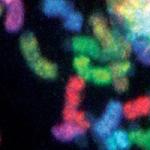
Research Topics
Causes and consequences of chromosomal instability (CIN) in budding yeast and human cancers
Goals and Objectives:
Chromosomal instability (CIN) is a hallmark of many cancers and a major contributor to tumorigenesis. CIN is characterized by unequal distribution of chromosomes into two daughter cells (numerical CIN) and/or structural rearrangements of the genome (structural CIN). Under selective conditions, CIN results in aneuploidy, which is observed in 90% of solid tumors. One of the key determinants for chromosomal stability is the centromere which serves not only as a site for kinetochore (centromere DNA and associated proteins) assembly but also a locus for kinetochore-microtubule (KT-MT) attachments and spindle assembly checkpoint function. Despite the differences in DNA sequences and size, all eukaryotic centromeres contain an evolutionary conserved histone H3 variant (CENP-A in humans, CID in flies and Cse4 in budding yeast). Restricting the localization of CENP-A is essential for faithful chromosome segregation. Mislocalization of CENP-A and its homologs to non-centromeric regions contributes to aneuploidy in yeast and flies. The proliferation of cancer cells is caused by dysregulation of evolutionarily conserved fundamental processes such as cell cycle control and chromosome segregation. The high degree of conservation between S. cerevisiae and human genes makes budding yeast an invaluable tool for cancer research and allow us to molecularly dissect the interplay between centromeric chromatin, cell cycle regulation, gene dosage, and chromosomal stability. Our research is focused on understanding the assembly and regulation of centromeric chromatin for faithful chromosome segregation. We have pioneered studies in these areas and our recent results show that a balanced stoichiometry of kinetochore proteins, topology of centromeric chromatin, post-translational modifications of centromeric histones and preventing the mislocalization of Cse4 to non-centromeric chromatin are essential for faithful chromosome segregation in budding yeast. Extrapolation of findings from yeast to humans shows that mislocalization of CENP-A contributes to CIN in human cells.
Project Summary:
We use multi-organismal (yeast, mouse and human cells) and multi-disciplinary (genetic, cell biology, biochemical and genome-wide) approaches to study faithful chromosome segregation, a fundamental process of every living cell. Genetic screens served as a starting point and in-depth mechanistic studies have provided evidence for new roles for kinetochore genes and the identification of new kinetochore genes. We also identified and defined roles for post-translational modifications (acetylation, methylation, phosphorylation, sumoylation and ubiquitination) of Cse4 in chromosome segregation. Our current research is aimed at understanding the role of Cse4-associated proteins in chromosome segregation and defining pathways that prevent mislocalization of Cse4 to non-centromeric regions.
In the first project we have defined roles for Scm3, Pat1, Cdc5 and Sgo1 for the assembly of centromeric chromatin and characterized role of post-translational modifications of centromeric histones in faithful chromosome segregation. Our results show that imbalanced stoichiometry of a Cse4 chaperone, Scm3 (HJURP in humans) leads to chromosome mis-segregation in both human and yeast cells thereby providing a link between HJURP overexpression and mitotic defects in cancers (Mishra et al., 2011). Scm3 interacts with Pat1 (Protein associated with topoisomerase II) and we have shown that Pat1 regulates the topology of centromeric chromatin (Mishra et al., 2013). We used a pat1 deletion strain to define the number of Cse4 molecules at the yeast kinetochore (Haase, Mishra 2013, Mishra et al., 2015) and provided evidence for a structural role for Pat1 in the structural integrity of centromeric chromatin and localization of Cse4 for faithful chromosome segregation. In addition to kinetochore proteins, association of cohesins with centromeres and along the length of the chromosomes ensures faithful segregation of sister chromatids during mitosis. We have shown that evolutionarily conserved polo kinase, Cdc5 associates with centromeric chromatin to facilitate the removal of centromeric cohesins (Mishra et al., 2016) and Cdc5-mediated phosphorylation of Cse4 regulates faithful chromosome segregation (Mishra et al., 2019). Furthermore, we determined that evolutionarily conserved Sgo1 which protects centromeric cohesion interacts with Cse4 and this is required for faithful chromosome segregation (Mishra et al., 2018). Our recent studies have shown that accumulation of R-loops at centromeric chromatin reduces the levels of centromeric Cse4 and Scm3 and contributes to chromosomal instability (Mishra et al., 2021). Biochemical approaches have allowed us to provide a comprehensive analysis of Post-translational modifications (PTMs) of Cse4. Conserved sites for acetylation, methylation, and phosphorylation were identified in Cse4 (Boeckmann et al., 2013). We determined that evolutionarily conserved Aurora B/Ipl1 kinase phosphorylates Cse4 in vivo and in vitro for faithful chromosome segregation. We provided the first evidence that yeast centromeres contain hypoacetylated histone H4 and that increased acetylation of histone H4 on lysine 16 (H4K16) leads to chromosome mis-segregation (Choy et al., 2011). Even though HDAC inhibitors (HDACi) are used in clinical trials we do not fully understand their mode of action. Hence, we performed a genome-wide screen with an HDACi to identify pathways that are vulnerable to altered histone acetylation. Our results showed that chromosome segregation mutants are more sensitive to HDACi (Choy et al., 2015). Future studies will allow us to understand the molecular role of PTMs of Cse4 in chromosome segregation and determine if these PTMs are conserved in human CENP-A.
In the second project we have focused on the identification of pathways that prevent mislocalization of Cse4 (CENP-A in humans) and CIN in yeast and human cells. For budding yeast, we showed previously that S. cerevisiae spt4 mutants show mislocalization of Cse4 and chromosome segregation defects that are complemented by human SPT4 (Basrai et al, 1996 and Crotti and Basrai 2004). We established the cause and effect of Cse4 mislocalization by showing that altered histone dosage and mislocalization of Cse4 to non-centromeric chromatin correlate with chromosome loss (Au et al., 2008, 2013). We determined that the N-terminus of Cse4 is required for ubiquitin-mediated proteolysis of Cse4 by E3 ligase Psh1 (Au et al., 2013). Our laboratory provided the first evidence for sumoylation of Cse4 and showed that ubiquitination of sumoylated Cse4 by Slx5 regulates its proteolysis to prevent mislocalization to euchromatin (Ohkuni et al., 2016, 2018). We have now defined a role for sumoylation of the N-terminus and C-terminus of Cse4 in localization to chromatin (Ohkuni et al., 2018, 2020). Genome-wide approaches used to identify regulators that prevent mislocalization of Cse4 identified a role for histone chaperones (Ciftci-Yilmaz et al., 2018). F-box proteins Cdc4 and Met30 (Au et al., 2020) and Dbf4 dependent kinase (DDK) (Eisenstatt et al., 2020) in proteolysis of Cse4. We recently showed that reduced gene dosage of histone H4 prevents mislocalization of Cse4 and CIN (Eisenstatt et al., 2021). Our ongoing studies are aimed at in-depth analysis of the yeast genes identified in the screen to understand the molecular mechanisms that prevent mislocalization of Cse4 for chromosomal stability.
For studies with human CENP-A we optimized cell biology-based assays to address a long-standing question of whether mislocalization of overexpressed CENP-A contributes to CIN. Given the clinical significance of high CENP-A expression and its correlation with cancer, it is critical to understand how CENP-A overexpression contributes to tumorigenesis and whether CENP-A expression can be exploited for prognosis, diagnosis and targeted treatment of CENP-A overexpressing cancers. We determined that constitutive or inducible expression of CENP-A in HeLa and stable diploid RPE1 cells results in mislocalization of CENP-A to non-centromeric regions. Comprehensive analysis for mitotic effects showed a dose-dependent effect of CENP-A overexpression on chromosome segregation defects and higher incidence of micronuclei. Our studies provide the first evidence for how mislocalization of CENP-A to non-centromeric chromatin contributes to CIN in human cells and provide mechanistic insights into how CENP-A overexpression may contribute to aneuploidy in CENP-A overexpressing cancers (Shrestha et al., 2017). We have now established that mislocalization of overexpressed CENP-A contributes to aneuploidy with karyotypic heterogeneity in human cells and mouse xenograft model (Shrestha et al., 2021). Human homologs of the yeast genes identified in genome wide screens show that evolutionary conservation of pathways that prevent mislocalization of CENP-A for genome stability. Studies with a transgenic mouse models are being pursued to examine the role of CENP-A overexpression in vivo. In summary, our studies using multi-organismal and multi-disciplinary approaches will provide mechanistic insights for how defects in kinetochore function contribute to aneuploidy in human cancers. We are optimistic that our studies will help translate basic science research to the clinic and aid in the diagnosis, prognosis and treatment of cancers that show overexpression of CENP-A.
Biography
Dr. Basrai received her Ph.D. from the University of Tennessee at Knoxville and did her postdoctoral research with Dr. Philip Hieter in the Department of Molecular Biology and Genetics at Johns Hopkins University School of Medicine in Maryland. Dr. Basrai joined the Genetics Branch at the NCI in 1998 and was promoted to tenure in 2006. Her research interests are genome stability and cell cycle regulation in yeast and human cancers. Dr. Basrai co-chairs the Cell Cycle Interest Group since 2005 and serves on the steering committee for the Center of Excellence of Chromosome Biology (CECB) since 2007. Dr. Basrai served on the Cancer Advisory Board for three years (2008-2011). Dr. Basrai has received the NIH Director’s Award and the NIH Award for Outstanding Mentorship towards the education of post-baccalaureate trainees. Her trainees have recieved numerous awards such as NIH Fellows Award for Excellence in Research and exceptional pay increase.
Selected Publications
- Ohkuni K, Suva E, Au WC, Walker RL, Levy-Myers R, Meltzer PS, Baker RE, Basrai MA. Deposition of Centromeric Histone H3 Variant CENP-A/Cse4 into Chromatin Is Facilitated by Its C-Terminal Sumoylation. Genetics. 2020;214(4):839-854.
- Eisenstatt JR, Boeckmann L, Au WC, Garcia V, Bursch L, Ocampo J, Costanzo M, Weinreich M, Sclafani RA, Baryshnikova A, Myers CL, Boone C, Clark DJ, Baker R, Basrai MA. Dbf4-Dependent Kinase (DDK)-Mediated Proteolysis of CENP-A Prevents Mislocalization of CENP-A in Saccharomyces cerevisiae. G3 (Bethesda). 2020;10(6):2057-2068.
- Au WC, Zhang T, Mishra PK, Eisenstatt JR, Walker RL, Ocampo J, Dawson A, Warren J, Costanzo M, Baryshnikova A, Flick K, Clark DJ, Meltzer PS, Baker RE, Myers C, Boone C, Kaiser P, Basrai MA. Skp, Cullin, F-box (SCF)-Met30 and SCF-Cdc4-Mediated Proteolysis of CENP-A Prevents Mislocalization of CENP-A for Chromosomal Stability in Budding Yeast. PLoS Genet. 2020;16(2):e1008597.
- Mishra PK, Olafsson G, Boeckmann L, Westlake TJ, Jowhar ZM, Dittman LE, Baker RE, D'Amours D, Thorpe PH, Basrai MA. Cell cycle-dependent association of polo kinase Cdc5 with CENP-A contributes to faithful chromosome segregation in budding yeast. Mol Biol Cell. 2019;30(8):1020-1036.
- Mishra PK, Basrai MA. Protein kinases in mitotic phosphorylation of budding yeast CENP-A. Curr Genet. 2019;65(6):1325-1332.
Related Scientific Focus Areas





Molecular Biology and Biochemistry
View additional Principal Investigators in Molecular Biology and Biochemistry
This page was last updated on Tuesday, January 21, 2025